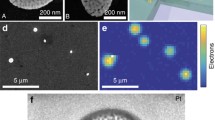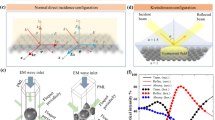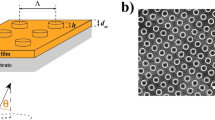Abstract
Applications based on the optical excitation of the longitudinal surface plasmon resonance of gold nanorods (AuNRs) work at highest efficiency if all component AuNRs can be maximally excited simultaneously. This can be achieved in aligned AuNR structures, such as those embedded in uniaxially stretched polymer films. Since too high heating temperatures during film stretching cause reshaping and alteration of optical properties of the rods, a maximum allowable heating temperature is determined. The alignment of the rods is quantified by an orientational order parameter of 0.92 based on a statistically significant sample of assumed t distributed means and obtained by scanning electron microscopy. We show that a stretched AuNRs-PVA composite film has optical properties that approach the dichroic properties of an idealized ensemble of fully aligned, identical, and non-interacting AuNRs embedded in a PVA film. The idealized system is provided by FDTD simulations of a single AuNR, which we carried out using the size- and shape-adapted dielectric function of gold and the software RSOFT.







Similar content being viewed by others
References
Bohren CF, Huffman DR (1983) Absorption and scattering of light by small particles. Wiley, New York
Kreibig U, Vollmer M (1995) Optical properties of metal clusters. Springer, Berlin
Maier SA (2007) Plasmonics: Fundamentals and Applications. Springer, New York
Link S, Mohamed MB, El-Sayed MA (1999) J Phys Chem B 103:3073–3077
Perez-Juste J, Pastoriza-Santos I, Liz-Marzan LM, Mulvaney P (2005) Coord Chem Rev 249(2005):1870–1901
Huang X, Neretina S, El-Sayed MA (2009) Adv Mater 21:4880–4910
Brioude A, Jiang XC, Pileni MP (2005) J Phys Chem B 109:13138–13142
Klar T, Perner M, Grosse S, von Plessen G, Spirkl W, Feldmann J (1998) Phys Rev Lett 80:19
Padilha L.A., Fontana J, Kohlgraf-Owens D, Moreira M, Webster S, Palffy-Muhoray P, Kik P.G, Hagan D. J, and Van Stryland E.W., (2009), OSA/CLEO/IQEC
van der Zande BMI, Koper GJM, Lekkerkerker HNW (1999) J Phys Chem B 103:5754–5760
Ahmed W, Kooij ES, van Silfhout A, Poelsema B (2009) Nano Letters 9(11):3786–3794
Mieszawska AJ, Slawinski GW, Zamborini FP (2006) J Am Chem Soc 128:5622–5623
van der Zande BMI, Page L, Hikmet RAM, van Blaaderen A (1999) J Phys Chem B 103:5761–5767
Wang Y, Teitel S, Dellago C (2005) Nano Letters 5(11):2174–2178
Liu Y, Mills EN, Composto RJ (2009) J Mater Chem 19:2704–2709
Murphy CJ, Sau TK, Gole AM, Orendorff CJ, Gao J, Gou L, Hunyadi SE, Li T (2005) J Phys Chem B 109:13857–13870
Devore J.L., (2012), Probability and Statistics for Engineering and the Sciences, Brooks/Cole
Hu Z, Fischbein MD, Querner C, Drndic M (2006) Nano Lett 6(11):2585–2591
Yan B, Yang Y, Wang Y (2003) J Phys Chem B 107:9159
Link S, El-Sayed MA (2005) J Phys Chem B 109(20):10531
Wilson O, Wilson GJ, Mulvaney P (2002) Adv Mater 14:13
Pollack GL, Stump DR (2002) “Electromagnetism”. Pearson Education Inc., Addison Wesley, San Francisco
Sandu T (2012) Springer Science+Business Media B.V. J Nanopart Res 14:905
Ashcroft NW, Mermin ND (1976) Solid State Physics. Saunders College, Philadelphia
Zhukov VP, Chulkov EV, Echenique PM (2006) Phys Rev B 73:125105
Genzel L, Martin TP, Kreibig U (1975) Z Physik B 21:339–346
Noguez C (2007) J Phys Chem C 111:3806–3819
Coronado EA, Schatz GC (2003) J Chem Phys 119:7
Liu M, Guyot-Sionnest P (2004) J Phys Chem B 108:5882–5888
Johnson PB, Christy RW (1972) Phys Rev B 6:4370–4379
Kittel C (2005) “Introduction to Solid State Physics”. Wiley, New York
Sönnichsen C, Franzl T, Wilk T, von Plessen G, Feldmann J (2002) Phys Rev Lett 88(Nr 7):5
Berciaud S, Cognet L, Tamarat P, Lounis B (2005) Nano Letters 5(3):515–518
Novo C, Gomez D, Perez-Juste J, Zhang Z, Petrova H, Reismann M, Mulvaney P, Hartland GV (2006) Phys Chem Chem Phys 8(30):3540–3546
Kumar R, Singh AP, Kapoor A, Tripathi KN (2004) SPIE Proceedings. Opt Eng 43(09):2134–2142
Yu C, Irudayaraj J (2007) Biophys J 93:3684–3692
Li J, Liu S, Liu Y, Zhou F, Li Z-Y (2010) Appl Phys Lett 96:263103
Acknowledgments
We wish to warmly thank Nicole A. MacDonald, physicist of Le Centre de Caractérisation Microscopique des Matériaux, Montreal, for her skillful efforts in taking the SEM images of the nanorods. Many thanks as well to Alex MacPherson and Juan Alfara of the Engineering Design and Manufacturing Laboratories of Concordia University for a crash course in SolidWorks and for manufacturing the device for stretching polymer films, respectively.
Author information
Authors and Affiliations
Corresponding author
Appendix
Appendix
A device for uniaxially stretching polymer films was designed as shown in Fig. 8.
The device was manufactured of aluminum paying attention not to generate stress concentration factors, such as sharp notches or scratches, in order to reduce the fracture risks of the composite film. The device was designed to be operated manually, which should enable a better control of the stretching process. This could be achieved by increasing or just maintaining the tensile stress in the film to allow for the disentanglement of the polymer chains until the desired stretch ratio is reached.
Rights and permissions
About this article
Cite this article
Stoenescu, S., Truong, VV. & Packirisamy, M. Dichroic Optical Properties of Uniaxially Oriented Gold Nanorods in Polymer Films. Plasmonics 9, 299–307 (2014). https://doi.org/10.1007/s11468-013-9623-x
Received:
Accepted:
Published:
Issue Date:
DOI: https://doi.org/10.1007/s11468-013-9623-x





